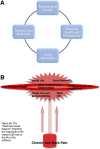Backing up the stories: The psychological and social costs of chronic low-back pain
- PMID: 25694901
- PMCID: PMC4300970
- DOI: 10.1016/j.ijsp.2013.02.001
Backing up the stories: The psychological and social costs of chronic low-back pain
Abstract
Background: Chronic low-back pain is a widespread condition whose significance is overlooked. Previous studies have analyzed and evaluated the medical costs and physical symptoms of chronic low-back pain; however, few have looked beyond these factors. The purpose of this study was to analyze and evaluate the personal and psychosocial costs of chronic low-back pain.
Methods: To measure the various costs of chronic low-back pain, a questionnaire was generated using a visual analog scale, the Depression Anxiety and Stress Scale, the Short Form 36 Health Survey, and the 1998-1999 Australian Bureau of Statistics Household Expenditure Survey (for demographic questions). The comprehensive survey assessing physical, mental, emotional, social, and financial health was administered to 30 subjects aged 18 years or older who had visited a tertiary spine service with complaints of chronic low-back pain.
Results: It was found that subjects scored significantly higher on scales for depression, anxiety, and stress after the onset of chronic low-back pain than before the onset of back pain. Subjects also reported a reduction in work hours and income, as well as a breakdown in interpersonal relationships, including marital and conjugal relations.
Conclusion: Chronic low-back pain affects the ability of a patient to work, creating both financial and emotional problems within a home. Relief is delayed for patients because of the sparse allocation of resources for chronic spinal care and inadequate prevention education. Despite this, many patients are exhorted to return to work before they are physically, mentally, or emotionally free of pain, resulting in poor outcomes for recovery. Ultimately, this aggregates into an adverse macrosocial effect, reducing not only the quality of life for individuals with chronic low-back pain but also workforce productivity.
Keywords: Chronic low-back pain; Cost; Depression.
Figures









References
-
- Punnett L, Prüss-Utün A, Nelson DI, et al. Estimating the global burden of low back pain attributable to combined occupational exposures. Am J Ind Med. 2005;48:459–69. - PubMed
-
- Australian Bureau of Statistics. 2011. Available from: URL: www.abs.gov.au. Accessed April 27, 2012.
-
- Walker BF, Muller R, Grant WD. Low back pain in Australian adults: prevalence and associated disability. J Manipulative Physiol Ther. 2004;27:238–44. - PubMed
-
- Walker BF, Muller R, Grant WD. Low back pain in Australian adults: the economic burden. Asia Pac J Public Health. 2003;15:79–87. - PubMed
LinkOut - more resources
Full Text Sources
Other Literature Sources
